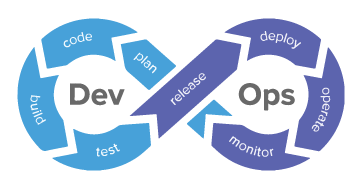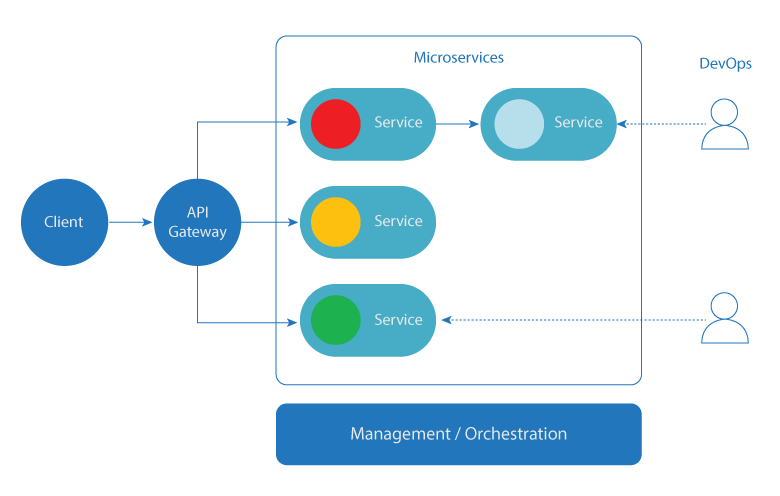
The cloud-native software architectures are not complete without microservices. Enterprises use modern practices like DevOps and microservices architectures to design software applications. This enables organizations to deploy these applications as independent services. And since DevOps and microservices are connected, they offer greater agility and operational efficiency.
DevOps helps developers and IT operations to work in close coordination with each other to deliver superior quality software quickly. It also allows developers to gain insights into production settings to improve the quality of their software.
Organizations follow DevOps practices to the cloud for replicating the production environment with better accuracy. DevOps facilitates easy collaboration amid development and IT ops teams and minimizes the resistance between them.
Microservice architecture on the other hand is a type of Service-Oriented Architecture (SOA), a software development technique. Microservices are tiny pieces of functionalities that are used as a service. These are independent building blocks, with the help of which it becomes easier to create, test and understand an application.
Since they offer greater modularity, several DevOps teams can construct and set up microservices side by side. Furthermore, it is easy to deploy microservices in any cloud. Hence, developers do not have to write specific codes for Microsoft Azure and AWS platforms separately.

The ultimate DevOps checklist for successful app deployment
DevOps is quickly gaining traction across enterprises. And due to the outbreak of the COVID-19 pandemic, more and more businesses are now turning towards the adoption of a DevOps culture to build, develop, test and deploy applications.
Basics of Microservices
Microservices is an architectural style that helps you to build an application as a compilation of the following services:-
- Easy to test and maintain
- Loosely joined
- Separately deployable
- Planned around business effectiveness
- Managed by a small team
Microservice architecture provides quick, recurrent and dependable delivery of huge and compound applications.

DevOps basics
DevOps is a combined shift of corporate culture that spins around the significance of information exchange and tools that supports coordinated environments. DevOps teams comprise of thoroughgoing associates who contribute in their unique way on every project. This shift creates a high-speed environment for deployments at regular intervals and the updates are done through CI/CD system.

Benefits of Microservices
The top benefits of deploying microservices include:
- Localized complexity:
- Increased business agility:
- Increased developer productivity:
- Future-proofed applications:
The owners of microservices are free from the worries of their service provider’s capabilities. They only have to realize the complexity of their service. This minimizes the complications and simplifies the creation and management of large applications.
Microservices are agile. They are comparatively small and simple, and their failure doesn’t affect the entire application. This helps developers to innovate better, may it be a new process or a business experiment.
Microservices is a small, isolated piece of functionality which is easy to comprehend. This makes it easy to accommodate new developers into projects.
Technologies keep evolving and it becomes mandatory to upgrade your system whenever innovations are integrated. Microservices architecture makes it easier to acclimatize by upgrading the system without impacting the functionality of the complete application.
How microservices fit into DevOps
DevOps practices have a simple principle. It focuses on breaking down huge problems into smaller ones and handling them in order of preference as a team. Likewise, Microservices also operate through small teams and make one functional change at a time. Besides, microservices can easily adjust the scaling without impacting the resource allocations for the remaining system. This simply indicates that the blend of DevOps and microservices in the development process is the fastest way to enhance the output of your teams.
Microservices and DevOps are bringing transformation together
An architecture based on microservices initiates change that is well-accepted by the ones who are involved in the process of creating modern applications. They experience a sudden increase in productivity and realize that it becomes easy and quick to deliver flexible and scalable solutions.
Microservices bring about some significant benefits in the field of DevOps like:
- Deployability
- Availability
- Scalability
- Modifiability
- Management
It provides enhanced agility facilitating the rollout of new services. This results in short cycles of development, testing and deployment.
Monolithic applications require a restart of the complete monolith to roll out updates. But microservices lead to a lesser downtime and support an early release.
Microservices are easy to scale independently using pools, clusters and grids; hence they are ideal for the elasticity of the cloud.
Microservices are loosely coupled, modular components that are flexible about new frameworks, libraries, data sources, etc.
As stated above, the development of an application is divided through smaller and independent teams which make its management easy.
Legacy system modernization and DevOps
DevOps is a culture and not just an approach to software development where CI/CD practices are mandatory. Three vital aspects matter a lot for organizations – people, processes and tools.
People, process, tools and DevOps
DevOps combines people, processes and tools. This helps businesses solve business challenges in a competent manner based upon the continuous chain of improvements. DevOps connects people to encompass a collective vision. It helps organizations to set up a people-first culture and minimizes the gap amid development and operation teams.
It is necessary to move traditional and manual processes to automated ones for the modernization of systems. This requires too much rework and may lead to delays. DevOps makes the use of CI/CD practices compulsory and focuses on automation. This streamlines pipeline and delivery.
Manual processes in legacy systems are tedious and time-consuming. Moreover, it is difficult for different teams to coordinate efficiently using legacy systems. DevOps establishes an easy and self-governing tool chain that simplifies the development and operation environment. These tools play a major role in the modernization process. They help developers to build, test and deploy repeatedly using automation and integration.
The essential key factors in the modernization process are:
- Automation
- Integration
- Transformation
- Optimization
Modernization with DevOps:
- Conversion of monolithic services into smaller microservices
- Better cloud technology leads to greater performance
- Implementation of CI/CD and deployment
- Use of container orchestration to automate deployment and scaling
Legacy systems lead to longer processes, decisions and delays in response times for every process. DevOps promotes smaller, continuous and faster transformation. This leads to quicker response time. Cloud, Microservices and DevOps work most finely when used together for an IT modernization project. Organizations must hire DevOps engineers and invest in the right tools and technologies. This helps them to design an unremitting modernization approach and stay ahead in the market competition.
Conclusion
The blend of DevOps and microservices enable organizations to develop faster at a lesser cost. This makes them more agile and productive. Microservices bring added productivity to DevOps as they can work on the same toolset for development and operations. This marks similar terminology and processes for requirements, reliance as well as obstacles. This way Devs and Ops can easily work together. When organizations don’t supplement DevOps with microservices, it can lead to competitive disadvantage and impact them negatively. To know more about how DevOps and microservices can improve your business processes and help in your business growth, talk to our experts.
The post DevOps and Microservices – Creating change together appeared first on softwebsolutions.


No comments:
Post a Comment